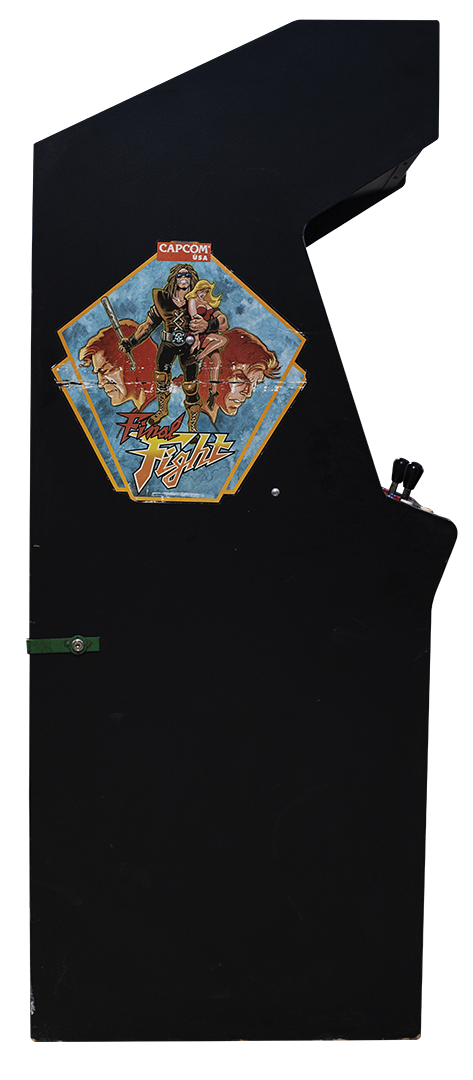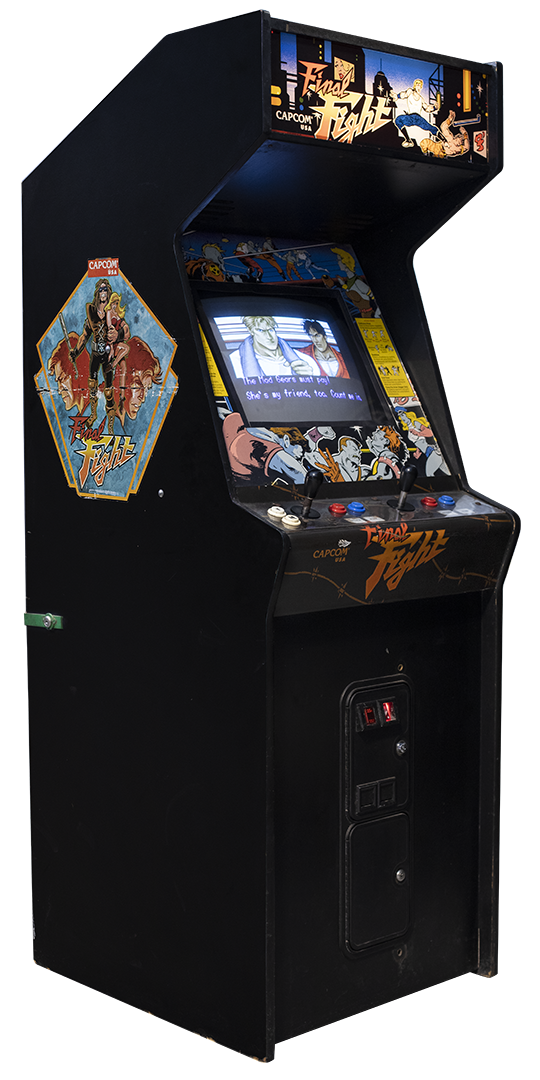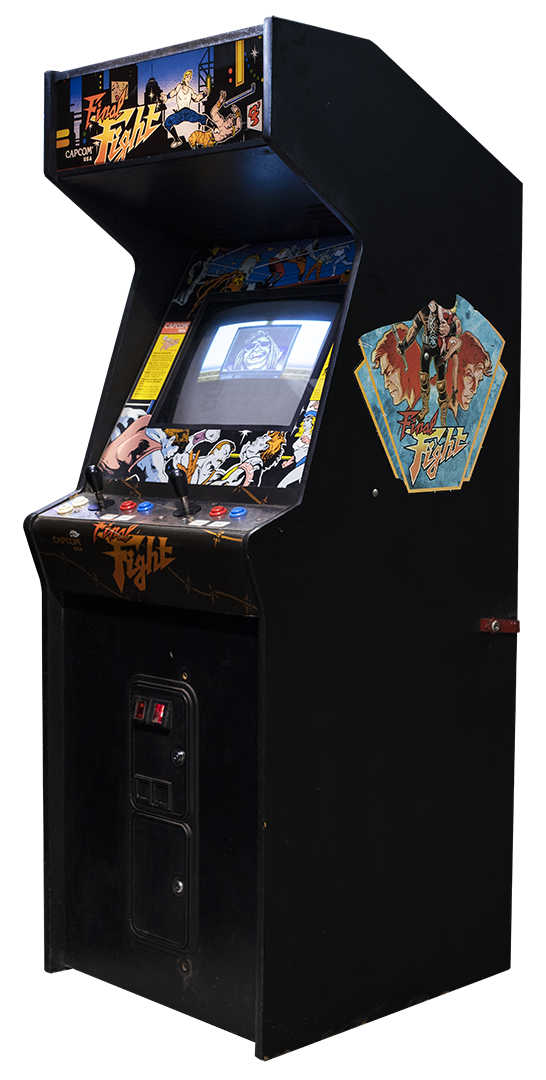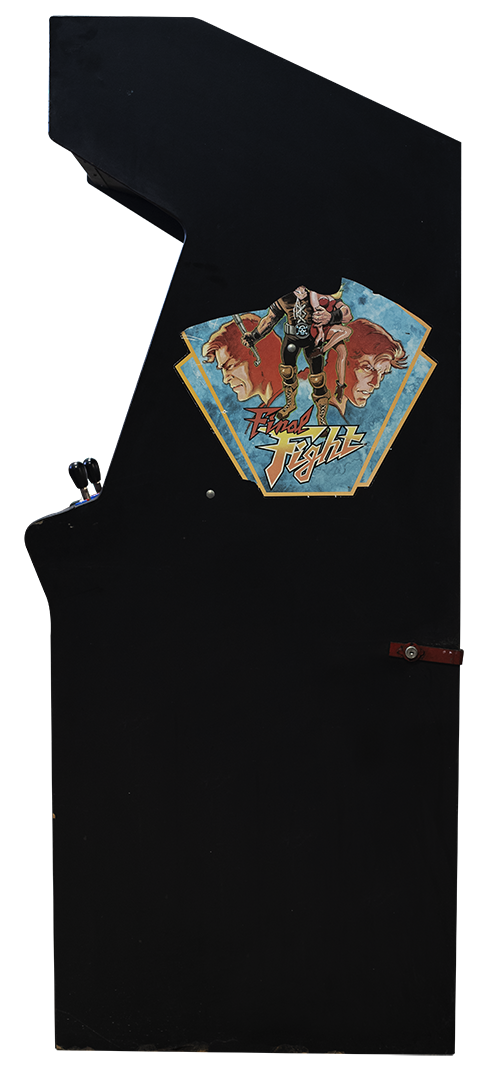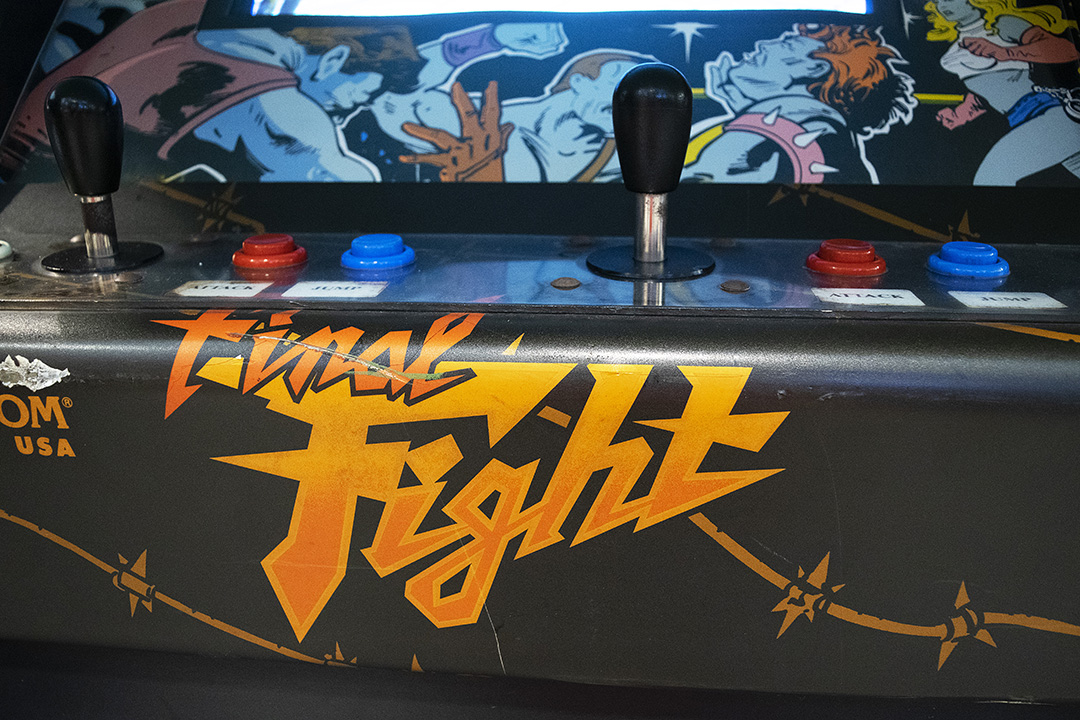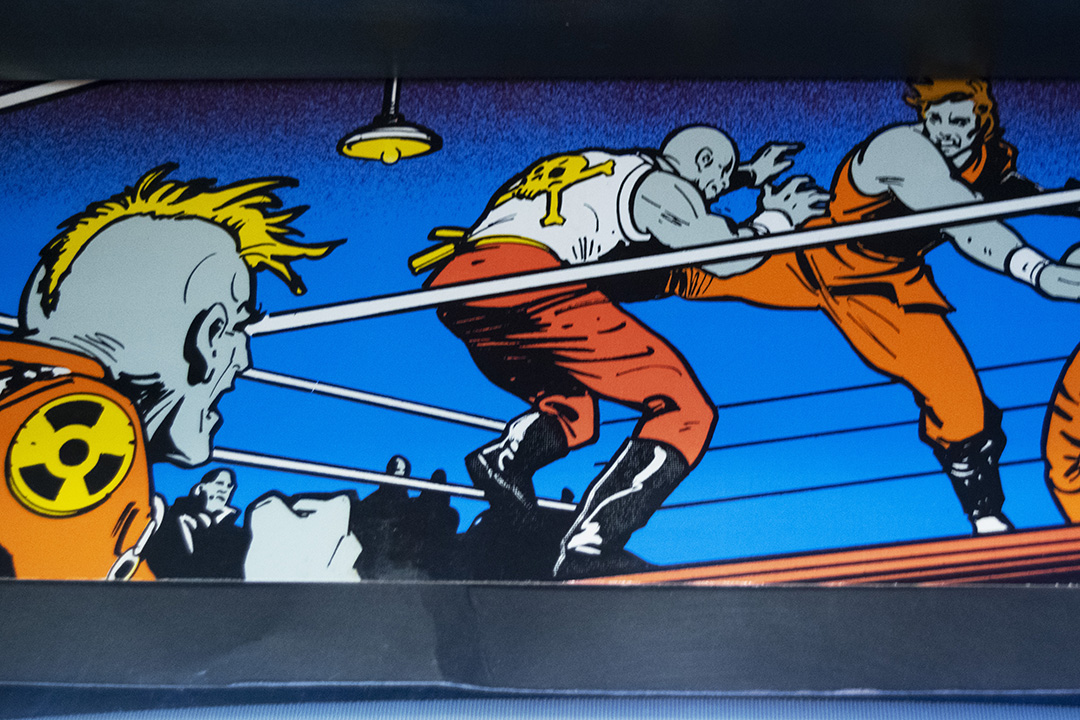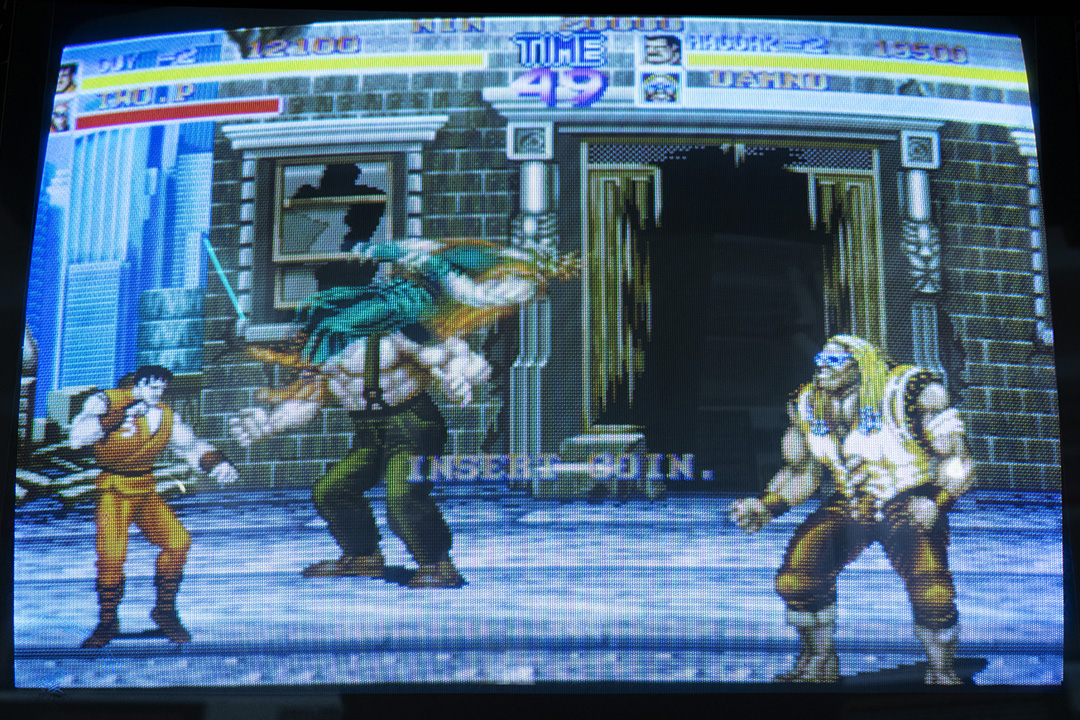
Final Fight
TECHNICAL DATASHEET
Game Name: Final Fight
Manufacturer: Capcom
Year of development: 1989
Category: Beat 'em up
Hardware Platform Info:
Capcom Play System board, also known as CP System, CPS or CPS-1. Same as other classics like Street Fighter II: The World Warrior, Strider, Ghouls'n Ghosts, U.N. Squadron or Captain Commando.
- Motorola 68000 Main CPU @ 10 MHz
- Zilog Z80 secondary CPU @ 3.579 MHz
- PPU 192 KB VRAM + 16 KB CACHE RAM
- Yamaha sound chip YM2151 @ 3.579 MHz and Oki OKI6295 @ 1 MHz (samples at 7.576 kHz)
- Video Resolution 384x224
- On-screen colors 4096 (192 global palettes, each of 16 colors) to choose from among 65536 (16-bit depth, of which 12 bits are RGB and 4 bits brightness level)
- Simultaneous sprites 256 of 16x16 with maximum 16 colors (15 opaque + 1 transparent)
- Size of tiles 8x8, 16x16, 32x32 with up to 16 colors (15 opaque + 1 transparent)
- Maps of tiles 3 maps of 512x512, 1024x1024, 2048x2048
- Supports horizontal or vertical screen orientation
Main developers: Noritaka “Poo” Funamizu (productor ejecutivo), Yoshiki “Kihaji.O” Okamoto (productor / jefe del departamento de investigación y desarrollo encargado de juegos para recreativas), Akira “[Pon G] Nin” Nishitani (diseñador jefe y director).
Programming and development: Akira “Akiman” Yasuda (diseñador y director de arte), Shinichi “Shin” Ueyama (programador), Satoru “S.Y” Yamashita (artista de personajes), Yoko “[Pon G2] Fukumary” Fukumoto (artista de escenarios), Asae “[Pon G 3] Nissui” Nishitsuji (artista de escenarios).
Music composers: Yoshihiro “Yuukichan's Papa” Sakaguchi (compositor jefe), Yoko Shimomura, Manami Matsumae, Harumi Fujita, Yasuaki Fujita, Hiromitsu Takaoka, Junko Tamiya.
GAME STORY
History of development:
Before the cultural phenomenon of Street Fighter II and after the success of the first Street Fighter, Capcom decided to produce another sequel that was initially going to be called Street Fighter '89. But they had to create a new team, since SNK had hired the two main people in charge of the first Street Fighter to create together sagas like Art of Fighting or Fatal Fury:
- Takashi "Piston Takashi" Nishiyama, who after designing the classics like Irem Moon Patrol or Kung-Fu Master created or directed several of the first successes of Capcom as Mega Man or the first Street Fighter. In SNK helped to create the system NeoGeo and produced among others, The King of Fighters, Fatal Fury Real Bout, Fatal Fury 3, Metal Slug 2 or Metal Slug X before setting up his own company Dimps, where, among other projects, would develop for Capcom Street Fighter IV or Street Fighter V, where Nishiyama would have the role of executive producer.
- Hiroshi "Finish Hiroshi" Matsumoto, who directed Art of Fighting and The Last Blade 2, produced The Last Blade, Art of Fighting 3 and many sequels of Fatal Fury like Real Bout or Mark of The Wolves. Later he went to Dimps with Nishiyama where he was executive producer of the first two Dragon Ball Z Budokai, as well as Street Fighter IV and Street Fighter V.
The group that took command would become a legend of arcade games, repeating in many classics such as Street Fighter II: Yoshiki Okamoto became in charge of the production of arcade games, Noritaka Funamizu would be executive producer, Akira Nishitani director and chief designer of the game and Akiman, who also worked on the first Street Fighter, co-design and would be the art director of the title.
Final Fight was the 7th game developed for Capcom's CPS board. Because Forgotten Worlds, the previous team game and first game for this board, had been less successful than expected they were going to have less graphics memory, ⅔ than the original Street Fighter had, so they decided to postpone the direct sequel to Street Fighter and develop a game of a different kind.
They sent Akiman to a fair in Los Angeles to see what kind of games were popular, and he looked at the beat 'em up. That must have happened in 1988, when Double Dragon, Bad Dudes Vs. DragonNinja, Vigilante, The Ninja Warriors, Dynamite Dux or Altered Beast came out. Nishitani saw that Double Dragon was selling a lot in Japan. That's where Final Fight was born. Nishitani focused on mechanical and gameplay design, while Akiman was in charge of the character design and visuals for the game.
Capcom's CEO suggested Akiman to be inspired by movies, so he was bases by Streets of Fire, directed by Walter Hill, and Hard Times, starring Charles Bronson.
Capcom was in a delicate financial state and was relying on the success of Final Fight. Fortunately, the game's revenues exceeded his expectations. It was a huge success that redefined the genre and influenced many titles.
According to Akira Yasuda, Nishitani and Okamoto, due to the success of Final Fight, the bosses asked them to make a sequel to it, but the development team, instead, decided to make Street Fighter II, a project they had already begun to outline before developing Final Fight.
General description of the game:
It's a beat 'em up game, a horizontal development action game in which we face a multitude of enemies along different levels by which in addition to walking back and forth we can move up or down, in which at the end there is usually a “final boss”.
There are 3 playable characters: Haggar, big and strong mayor of Metro City who will fight against the Mad Gear gang, which has kidnapped his daughter Jessica. Cody, knife expert and Jessica's boyfriend. Guy, fast and skillful ninja, friend of the other protagonists.
They can play one or two players at the same time in a cooperative way, with a lever to move the character, a jump button and a kick button. By pressing both buttons at the same time while the characters are on the ground, the protagonists sacrifice a piece of their energy bar to make a very powerful special attack that is usually very useful when you are surrounded by enemies.
While walking, you can find breakable objects such as barrels or wooden boxes that usually contain bonus items such that give points (clock, gold bar, gems, radio, money ...) or others that also bring back to life (hot dog, pizza, fruit, drinks, chewing gum ...). We can also find weapons such as knives, pipes or katanas.
Curiosities:
- Many of the names of the characters are inspired by singers, groups or rock songs.
- The intro of the western versions, are censored with respect to the original Japanese version, replacing a scene in which Jessica appears in her underwear with the Capcom logo.
- At that time it was not usual to have female characters as enemies, so to avoid complaints because in the game women were beaten, Poison was designed as a transsexual without operating. In the western versions this was not enough, so she and Roxy (a character who came to be Poison with other colors), were replaced respectively by the male characters Billy and Sid.
- In the version for Mega CD, Poison was also censored, in this case covering more her body, changing her top for a T-shirt and her shorts for longer pants.
- Akira Nishitani, the game's chief designer, has hated side-scrolling action games since the days of Final Fight.
- In Final Fight 2, Chun-Li and Guile appear on the Street Fighter II scenarios, and in different episodes of the Street Fighter saga, characters, bonus phase and Final Fight scenarios have been incorporated, thus linking the universes of both sagas.
- Captain Commando, another game of the same genre, is set in a futuristic version of Metro City, a fictitious American city inspired in New York that was created for Final Fight and also appears in other games of the Street Fighter saga.
- The character Sodom is called Katana in Western versions of both the adaptations of the game for SNES and Mega CD and Street Fighter Alpha 2 for SNES. The same thing happens with Damnd, who was renamed Thrasher.
- In the Western version for Super Nintendo, the bonus item that is a bottle of whisky and the phrase "OH! MY GOD!!" exclaimed by the owner of the broken car was also censored, replacing it with "OH! MY CAR".
- The SNES adaptation does not contain the elevator phase, nor Guy as a playable character. Later, Final Fight Guy was released, a version that replaced Cody with this ninja.
- Mike Haggar appears alongside Jessica in Saturday Night Slam Masters and its two sequels, Muscle Bomber Duo and Slam Masters II: Ring of Destruction as well as in Marvel vs. Capcom 3 or Marvel vs. Capcom: Infinite or with Guy in Namco x Capcom.
- The American Street Fighter II series of drawings had a chapter dedicated to Final Fight. Several of the stories from the Street Fighter comics made by Udon are also dedicated to Final Fight.
- At the base of the 4 pillars just before facing the last enemy of the game, there are hidden gems.
- If you eat Edi.E's gum, the final enemy, who is a corrupt policeman, you recover 64% of the energy bar and earn 42,910 points, the maximum given to you by an item in the game.
- To win gems or other items of very high score, you have to break things like barrels or litter bins with the air attack while you press down. Just then press very quickly left and right.
- Unlike the other characters, Cody can punch the arrows thrown by Belger, the last enemy in the game, and use the knives to stab as well as throw them.
HISTORY OF THE MACHINE IN ARCADE VINTAGE
Status: OPERATIONAL
Information about the location and purchase by Arcade Vintage:
Machine purchased in June 2018 at Coin Op Wharehouse, Maryland (USA).
Information on the restoration process or repairs carried out:
After adapting a 220v transformer and making the necessary adjustments to the monitor and control panel, the machine works perfectly.
Pending repairs or restorations:
Changing the joysticks.
